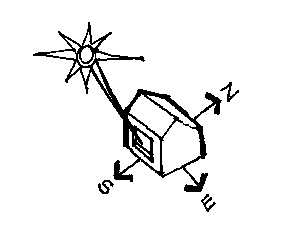| Building Form/ Shape
Design Considerations:
Energy efficiency- A circular or square building shape will hold
heat better than a long, rectangular building.
Harmony with environment- Locate building in a space that does not
block views of the surrounding environment from surrounding buildings. Locate the
building in a space which does not shade existing vegetation that needs ample amounts of
sunlight. Locate the building in a space which removes the least amount of trees.
Tools:
DOE- 2 computer modeling helps to calculate the varying conditions of fundamental building
components
Case Studies to research:
Harmony with environment -
Paulk Residence, Seabeck, Washington - The site was disturbed as little as possible.
Footings were hand-dug to minimize soil disturbance.
-Reeves Residence, Dewees Island, South Carolina - The building was located on a site
where the fewest trees were removed.
Further Information:
“Lady Bird’s Legacy”, Dillon, David. Architecture. Vol.84,
no.7, July 1995, pp. 68-74.
“Flora + Fauna”, Mays, Vernon. Architecture. Vol.87, no.7, July 1998, pp.
68-75.
Moore, F. Environmental Control Systems: Heating, Lighting, Cooling. New
York: McGraw-Hill, Inc, 1993.
National Audubon Society Audubon House: Building the Environmentally Responsible,
Energy-Efficient Office. New York, NY: John Wiley and Sons, Inc. 1994
The Ecology of Architecture: A Complete Guide to Creating the Environmentally
Conscious Building by Laura Zeiher.
Web resources:
U.S. Department of Energy: EPIC - Pollution
Prevention Information Clearinghouse. |
|

